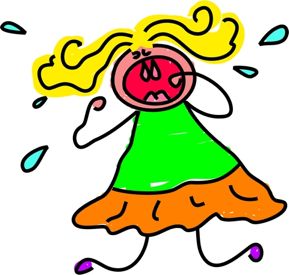 If you did the ABC homework we outlined in Part 2, you should have a clearer idea of what is triggering your child’s tantrums and under which category the antecedents (triggers) fall. The next step is to implement the behaviour management strategies to manage challenging behaviours. (To find the right strategies for you and your child, look under the applicable antecedent category.) As you’re doing so, remember to reinforce every time Tina or Thomas acts appropriately. Consistent and frequent praise goes a long way in shaping positive behaviour.
If you did the ABC homework we outlined in Part 2, you should have a clearer idea of what is triggering your child’s tantrums and under which category the antecedents (triggers) fall. The next step is to implement the behaviour management strategies to manage challenging behaviours. (To find the right strategies for you and your child, look under the applicable antecedent category.) As you’re doing so, remember to reinforce every time Tina or Thomas acts appropriately. Consistent and frequent praise goes a long way in shaping positive behaviour.
ESCAPE
Antecedent strategies
– Clearly cue the beginning and end of tasks. Set a timer so Tina or Thomas can see the countdown and hear when it’s okay to wrap up. Start with a minute or two and increase the time incrementally as behaviour improves.
– Intersperse less preferred activities with ones Thomas loves. Make a first-then board to help him understand the sequence of events. On the left side (under First) of your board, put a picture or word to show the must-do task; do the same on right side (under Then) for the reward activity.
– Have behavioural rehearsals. Read social stories, watch Model Me Kids videos and role-play to help teach positive behaviour.
Consequence strategies
– Follow through with the task request. Your child’s outbursts should not make the demand go away.
-Wait to give Tina her desired activity or item until she has complied with your instruction.
ATTENTION-SEEKING
Antecedent strategies
-Schedule frequent bouts of one-to-one time. Use timers and first-then boards, so your child knows when you’ll focus on him.
-Give Tina or Thomas interesting things to do, such as puzzles, books or blocks, while waiting for your attention.
Consequence strategies
-Ignore the behaviour. Busy yourself with an activity, such as reading a book or making lunch, while your child is acting out (providing it’s safe to do so).
-Stay neutral. Your reactions, even small ones like a furrowed brow, will fuel Thomas’ fire.
TANGIBLE
Antecedent strategies
-Provide scheduled toy and activity changes. Let Tina know that a transition is coming by counting down from 10 or using a timer for a 1-minute warning. Point out what’s next on her visual schedule.
-Organize Thomas’ day so that fun things always follow unappealing activities. Post a visual schedule that shows the sequence of events, so he knows what to expect throughout the day.
Consequent strategies
-Avoid giving Tina the toy or activity that triggered her meltdown.
-Redirect your child to another item or activity. Wait until he is calm for 5 seconds, then prompt him to ask appropriately.
SENSORY
Antecedent strategies
-Keep Tina engaged as much as possible. The more downtime she has, the more likely she is to practice stereotypic behaviour.
-Provide your child with leisure activities, such as jumping on a trampoline, listening to music or playing in a sandbox, that provide sensory feedback similar to her self-stimulatory behaviour.
Consequence strategies
– Block or interrupt the behaviour. For example, redirect hands down when they’re trying to rip, flap, or spin or stand between Tina and the wall to block head banging.
– Guide Thomas to a more appropriate activity. Give him a stress ball to squeeze, a chew toy to nibble or foot massager to roll his feet on.
Keep in mind that meltdowns can get worse before they get better. Don’t give up, however, because your consistency will lead to more positive behaviour. If you need more help taming tantrums, turn to us. We’re always here to help!


Pingback: How to Manage Challenging Behaviour – Part 2 - How to ABA
Comments are closed.